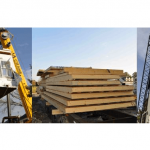4 Key Factors to Consider When Choosing Land to Build Your Home


Having land for building a new custom home is a critical first step in the process. For some, they already have the land or they have been gifted the land from family members. For others, it is a process they must go through prior to starting the construction of their new home. In many cases, there are four key factors that must be considered before you begin to build.
Access to Utilities
Not all land is created equal, especially regarding utility access. This means things like access to water, sewer/septic, electric, cable, phone, etc. Most people don’t know that much about these items because they have never really had to. They already had access to them where ever they lived. As usual, these items can vary widely by location. If the land you are looking at has access to some of them, hopefully, this saves you money.
Access to public sewer systems can be great. Just make sure to learn about tap fees, capacity fees, or any other connection fee that the provider may charge. Septic systems are typically needed when you don’t have access to public sewer. If you have to have a septic system, find out what kind BEFORE you purchase the land. There are several levels of septic systems, usually referred to as conventional or alternative. Alternative systems are usually more expensive. Make sure that the land has already been tested so that it can have a septic system. Don’t buy it until you are sure. Land that doesn’t have access to sewer and can’t get approved for a septic system is essentially worthless for your new home.
If the land has access to public water, be sure to ask about connection fees, tap fees, or any other fee associated with connecting to the utility. Also, don’t assume because a piece of land has access to the public sewer that it will have access to public water or vice versa… always ask. If you don’t have access to a public water supply, the usual alternative is to drill a well. Find out about typical well depths in your area. Learn about the costs for those wells. Ask about issues with well water that might require you to purchase a water softener or some other treatment system.
Related: 10 THINGS YOU WISH YOU HAD THOUGHT ABOUT FOR YOUR NEW HOME
When it comes to power, find out where the closest electrical service access is located. Will the access be underground or from poles? Who pays for it? Call the local electric utility if you need to get the answers for a specific piece of property.
Most buyers assume every building site has access to phone, cable, and the internet. You know what can happen when you assume. Just like electric, find out about access to each of these systems. If you are used to high-speed internet and it isn’t available on a piece of property, how will this affect you? Is a satellite dish a viable alternative? Is there phone service to the site or does it need to be brought there? Who pays if it needs to be brought to the site? Again, all questions to ask the local provider to make sure you get the right answer.
Home Site Location
 When shopping for the perfect piece of land for your new home, you are probably looking for some specific features. Examples could be: proximity to a certain school system, an easy commute to work, a great view, a great price, etc.
When shopping for the perfect piece of land for your new home, you are probably looking for some specific features. Examples could be: proximity to a certain school system, an easy commute to work, a great view, a great price, etc.
What some people fail to think about is exactly how their home is going to be positioned on the piece of land once they have purchased it. A good example is outdoor living space. Are you a patio or deck lover? Do you look forward to that evening cookout with friends and family when you move into your new home? What if your new deck/patio is on the south/southwest facing side of your home? You are going to experience lots of hot, uncomfortable cookouts.
This is just an example so that you start thinking now about how you plan to use your home and how to position it on your land. A partial list of other items can include: What are good window locations and heights? How much light will you have in your kitchen? How steep will your driveway be? etc. Once you have thought through items like these it will help you choose the land, allow you to incorporate its features into the design of your home, and finalize the specific location of the home on the land.
Land Features
For some, certain aspects are critical when building a new home. One could be a walk-out basement with no steps. However, you may also want a level lot. Unless you want your home to sit very high on a foundation, it is hard to make that work. Make sure that if you want a certain feature that the land you choose will accommodate it.
Another item to think about is trees. Trees are natural… they can provide shade, can be used as a wind break, and can provide lots of landscaping appeal to a home. Trees also get blown over, shed limbs, and shed leaves or needles. Think through how close you really want existing trees to your home. Broken or clogged rain gutters can lead to water pooling around your foundation.
Rocks can also be an issue in some areas. Just because you see them doesn’t mean you will have issues but if you have solid rock, foundations will be more expensive. Either equipment will need to be brought in to break it up or, in extreme cases, blasting will be necessary. In either case, it means extra expense.
Accessible for Delivery of Modules
One of the key things that have to be verified when you build a modular home is that the modules can be delivered to the home site. Keep in mind, modules can range from 12′ to 16’+ wide. They can be 30′ to 80′ long. While highly skilled drivers and specialized trucks are used to transport the modular sections to your home site, in some cases trees, road widths, curves, power lines, poles, signs, or other features won’t allow access to the site. Another thing to verify is that the site or a nearby staging area is accessible to store the modules in preparation for placement of the modules on the foundation at the home site.
Finally, your building site must have room to allow the modular sections to be installed. Generally, a crane is needed to place the home modules on your foundation. Typically, cranes need to have a space that is about 30′ wide and 50′ long and free of power lines to set up. Then, space is needed beside of it to place each section of the home so it can be lifted and placed on the foundation. When in doubt, a site review is required to ensure a smooth delivery and set.
The post 4 Key Factors to Consider When Choosing Land to Build Your Home appeared first on Impresa Modular.




